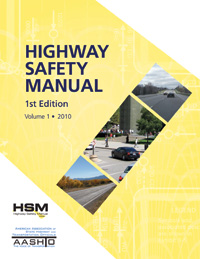CMF Update, Summer 2010
The Summer 2010 edition of CMF Update is the first edition of the Crash Modification Factors Clearinghouse e-newsletter. To subscribe to our newsletter, please visit http://www.cmfclearinghouse.org/newsletter_signup.php.
Over 500 CMFs Added Since Clearinghouse Launch
Since the Crash Modification Factors (CMF) Clearinghouse was launched in December 2009, over 500 new CMFs have been added to the online resource. Collectively, the clearinghouse now contains over 2,400 CMFs for over 580 countermeasures. Highlights of the newly added CMFs include:
Replace 8-inch signal heads with 12-inch heads
CMF: 0.58
CRF: 42
Star Quality Rating: ![]()
Implement truck lane restrictions on 4-lane freeways
CMF: 0.68
CRF: 32
Star Quality Rating: ![]()
Increase separation distance between driveway exit and downstream U-turn by 10%
CMF: 0.97
CRF: 3
Star Quality Rating: ![]()
Install raised median
CMF: 0.45
CRF: 55
Star Quality Rating: ![]()
The CMF Clearinghouse will be updated on a regular basis to add recently developed and documented CMFs. New CMFs will be identified via a periodic review of published literature. In addition, the CMF Clearinghouse provides a mechanism for transportation professionals to submit their own CMFs to be considered for inclusion.
CMF-Related Trainings Available through NHI
Practitioners interested in learning more about crash reduction factors (CRFs) can take advantage of two trainings offered through the National Highway Institute.
The first course, Application of Crash Reduction Factors, includes a Web-based training that covers the background of CRFs, including terminology, the components of a CRF, and how to identify and interpret appropriate CRFs. The training also includes an instructor-led training session that provides a hands-on experience with safety diagnosis and the application of CRFs to compare the effectiveness of countermeasures.
The second course, Science of Crash Reduction Factors, provides participants with the knowledge and skills needed to critically assess the quality of CRFs. The course covers the concepts underlying the measurement of safety and the development of CRFs/, specifically the key statistical and methodological issues that affect the development of quality CRFs.
To download informational fliers and watch a short video about each course, please visit http://www.cmfclearinghouse.org/resources_trainings.php
Featured Resource: Highway Safety Manual
AASHTO recently released the First Edition of the Highway Safety Manual (HSM). The HSM provides practitioners with the best factual information and tools to facilitate roadway design and operational decisions based on explicit consideration of their safety consequences. One of these tools is the inclusion of crash modification factors, which can be used to support an agency's roadway safety management process or as input to the safety prediction methods.
To find out more about the HSM, please visit http://www.highwaysafetymanual.org/
Featured FAQ: What's the Difference between a CRF and a CMF?
The main difference between CRF and CMF is that CRF provides an estimate of the percentage reduction in crashes, while CMF is a multiplicative factor used to compute the expected number of crashes after implementing a given improvement. Both terms are presented in the Clearinghouse because both are widely used in the field of traffic safety.
Mathematically stated, CMF = 1 - (CRF/100). For example, if a particular countermeasure is expected to reduce the number of crashes by 23% (i.e., the CRF is 23), the CMF will be 1 - (23/100) = 0.77. On the other hand, if the treatment is expected to increase the number of crashes by 23% (i.e., the CRF is -23), the CMF will be = 1 - (-23/100) = 1.23.
These reduction estimates might also be expressed as a function. Crash reduction and crash modification factors are constants; crash modification functions allow the factor to vary for different scenarios, such as for different traffic volume scenarios.
For more answers to frequently asked questions, please visit http://www.cmfclearinghouse.org/faqs.php
Submit your CMFs to the Clearinghouse
The CMF Clearinghouse welcomes CMF study submissions to be included in its searchable database. Please use the provided form at http://www.cmfclearinghouse.org/pubsubmit.php to submit your study. Prior to submitting, please be sure to search before submitting a new CRF as it may already be listed. You may either submit a link to a resource already existing on the web (preferred) or upload your own file. Submissions might include published research studies that are not presented in the Clearinghouse, or state-specific CMFs that were developed as part of the HSIP.



